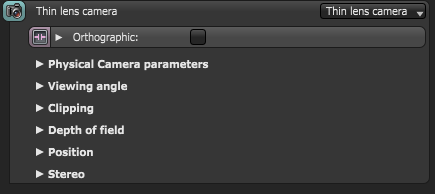

Figure 1: The parameters of the Thin Lens camera in the Node Inspector
Orthographic
If enabled, the camera will render an orthographic view. If disabled, the camera will show a perspective view.
Sensor Width/Focal Length/F-stop
These allow you to control the Field of ViewThe area that is visible to a camera lens usually measured in millimeters. A wide angle lens provides a larger field of view and a telephoto lens provides a narrow field of view. (FOVThe area that is visible to a camera lens usually measured in millimeters. A wide angle lens provides a larger field of view and a telephoto lens provides a narrow field of view.) and Depth of FieldThe distance between the nearest and farthest objects in a scene that appear acceptably sharp in an image. Although a lens can precisely focus at only one distance at a time, the decrease in sharpness is gradual on each side of the focused distance, so that within the DOF, the unsharpness is imperceptible under normal viewing conditions. source: wikipedia (https://en.wikipedia.org/wiki/Depth_of_field) (DOFThe distance between the nearest and farthest objects in a scene that appear acceptably sharp in an image. Although a lens can precisely focus at only one distance at a time, the decrease in sharpness is gradual on each side of the focused distance, so that within the DOF, the unsharpness is imperceptible under normal viewing conditions. source: wikipedia (https://en.wikipedia.org/wiki/Depth_of_field)) similar to a real-world camera.
Sensor Width
The width of the sensor or film in millimeters.
Focal Length
The focal length of the lens in millimeters.
F-stop
This is the aperture to focal length ratio.
Field of View
This sets the horizontal field of view for the camera in the scene, measured in degrees. When choosing a large value, more of the scene can be seen in the camera. A smaller value will reduce the amount visible through the camera.
Scale of View
This sets the width of the orthographic view of the camera, the units used is in meters.
Pixel Aspect Ratio
This allows you to stretch or squash the Depth of Field disc and render to a non-square pixel format (like NTSC or PAL).
ApertureDetermines how much light enters a camera lens. A large aperture produces a narrow depth of field and a small aperture produces a wide depth of field.
The aperture is the radius of the lens opening of the camera used in the scene, measured in centimeters. Choosing a low value will have a wide depth of field where everything is in focus. Choosing a high value will create a shallow depth of field (DOF) where objects in the foreground and background will be out of focus.
Aperture Aspect Ratio
This allows users to stretch/squash the Depth of Field disc.
Aperture edge
This controls aperture edge detection at all points within the aperture. The lower values will give more pronounced edges to out of focus objects affected by the a shallow depth of field (DOF) such as objects in the foreground and background. The aperture edge modifies the bokeh effect of the depth of field. A high value increases the contrast towards the edge.
Auto-Focus
If enabled, the focus will be kept on the closest visible surface at the center of the image, regardless of the aperture, the aperture edge, and focal depth values. This setting is on by default.
Focal Depth
The depth of the plane in focus, measured in meters. If you are having trouble seeing a result when you adjust this setting, double-check to make sure that Auto-Focus is enabled. Auto-Focus will override the Focal Depth setting.
Near Clip Depth
Distance from the camera to the near clipping plane, measured in meters.
Lens Shift
This is useful for architectural rendering, when users want to render images of tall buildings/structures from a similar height as the human eye, but keep the vertical lines parallel.
Distortion
This adjusts the spherical and cylindrical distortion. The rendered image displays the entire sphere and uses equidistant cylindrical projection also known as lat-long projection.
Position
The X,Y,and Z position of the camera in the scene.
Target
This is the target position where the camera is pointed in the scene.
Up-Vector
This is the up direction of the camera in the scene. By default this is in the Y-direction (0,1,0).
Perspective Correction
If Up-Vector is vertical, enabling this option keeps vertical lines parallel.
Stereo Mode
Users can enable stereo mode and choose whether to use off-axis or parallel stereo camera projections.
Stereo Output
This specifies the output rendered in stereo mode.
Eye Distance
This is the distance between the left and the right eye in stereo mode, measured in meters.
Left Stereo Filter / Right Stereo Filter
The left and right filter colors used to create the anaglyphic stereo affect in the render.